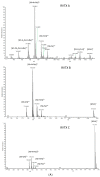On the Hunt for New Toxin Families Produced by a Mediterranean Strain of the Benthic Dinoflagellate Ostreopsis cf. ovata
- PMID: 35448843
- PMCID: PMC9030729
- DOI: 10.3390/toxins14040234
On the Hunt for New Toxin Families Produced by a Mediterranean Strain of the Benthic Dinoflagellate Ostreopsis cf. ovata
Abstract
Ostreopsis cf. ovata is a benthic dinoflagellate known to produce palytoxin (PLTX) and its analogues. Recent investigations suggested the production of unknown toxins by a Mediterranean strain. In the present work, two new families of toxins, potentially novel in their structures, were purified from this same Mediterranean strain of Ostreopsis cf. ovata. The low amount of material isolated only allowed for acquisition of high-resolution mass spectrometry data and the evaluation of their cytotoxicity to human lung cancer cells. Based on their HRMS data, none of these new compounds appear to be close PLTX analogues, although their mass spectra suggest poly-hydroxylated long chain compounds of high molecular weight (1370-2143 Da). The cell cytotoxicity concentrations (CC50) of these new purified toxins ranged between 0.68 and 3.12 µg/mL, and this was enhanced when they were tested as mixtures, suggesting synergistic effects of Ostreopsis toxins. The two families of compounds were named the liguriatoxins (LGTX) and rivieratoxins (RVTX), with each family containing three members. Additional work on purification is needed to fully characterize the structures of these six new dinoflagellate toxins.
Keywords: Ostreopsis; cytotoxicity; high resolution mass spectra; polyhydroxy compounds; toxins.
Conflict of interest statement
The authors declare no conflict of interests.
Figures









References
-
- Ciminiello P., Dell’Aversano C., Fattorusso E., Forino M., Magno G.S., Tartaglione L., Grillo C., Melchiorre N. The Genoa 2005 Outbreak. Determination of Putative Palytoxin in Mediterranean Ostreopsis Ovata by a New Liquid Chromatography Tandem Mass Spectrometry Method. Anal. Chem. 2006;78:6153–6159. doi: 10.1021/ac060250j. - DOI - PubMed
-
- Vila M., Abós-Herràndiz R., Isern-Fontanet J., Àlvarez J., Berdalet E. Establishing the Link between Ostreopsis Cf. Ovata Blooms and Human Health Impacts Using Ecology and Epidemiology. Sci. Mar. 2016;80:107–115. doi: 10.3989/scimar.04395.08A. - DOI
-
- Rossi R., Castellano V., Scalco E., Serpe L., Zingone A., Soprano V. New Palytoxin-like Molecules in Mediterranean Ostreopsis cf. Ovata (Dinoflagellates) and in Palythoa tuberculosa Detected by Liquid Chromatography-Electrospray Ionization Time-of-Flight Mass Spectrometry. Toxicon. 2010;56:1381–1387. doi: 10.1016/j.toxicon.2010.08.003. - DOI - PubMed
-
- David H., Laza-Martínez A., Miguel I., Orive E. Ostreopsis cf. siamensis and Ostreopsis cf. ovata from the Atlantic Iberian Peninsula: Morphological and Phylogenetic Characterization. Harmful Algae. 2013;30:44–55. doi: 10.1016/j.hal.2013.08.006. - DOI

